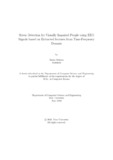Stress detection for visually impaired people using EEG signals based on extracted features from time-frequency domain
Abstract
Stress refers to body's physical, emotional and psychological reaction to any environmental
change needing adjustment with major impact on human psychology.
Stress is specially di cult to manage for visually impaired people (VIP) as they can
become easily stressed in unknown situations. Electroencephalogram (EEG) signals
can be used to detect stress as it basically represents the ongoing electrical signal
changes in human brain. Literature shows that the stress detection techniques are
mostly based on either time or frequency domain analysis. However, using either
time or frequency domain analysis may not be su cient to provide appropriate outcome
for stress detection. Hence, in this paper a method is proposed using empirical
mode decomposition (EMD) and short-term Fourier transform (STFT) are used to
extract features considering spatio-temporal information from EEG signals. In the
EMD, the signal is rst decomposed into intrinsic mode functions (IMFs) representing
a nite number of signals while maintaining the time domain and STFT is
used to convert time domain to time-frequency domain. Support vector machine
(SVM) is applied to classify the stress of VIP in unfamiliar indoor environments.
The performance of the proposed method is compared with a state-of-the-art technique
for stress detection. The experimental results demonstrate the superiority of
the proposed technique over the existing technique.

